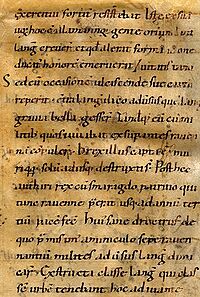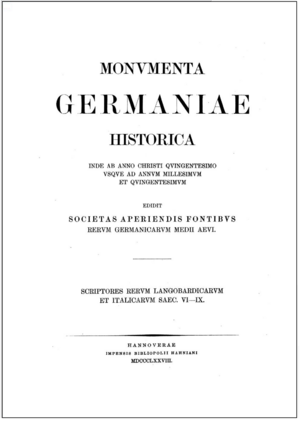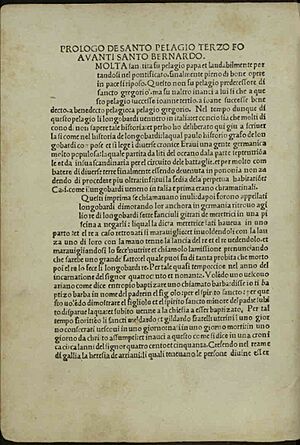History of the Lombards facts for kids
Quick facts for kids History of the Lombards |
|
|---|---|
| Historia Langobardorum Historia gentis Langobardorum |
|

Salzburg manuscript
|
|
| Author(s) | Paul the Deacon |
| Language | Latin |
| Date | 787–796 |
| Provenance | Monte Cassino |
| Manuscript(s) | 115 extant manuscripts |
| Principal manuscript(s) | Codex Sangallensis 635 |
| First printed edition | 1514 |
| Genre | Ethnic history |
| Subject | History of the Lombard people |
The History of the Lombards (also known as Historia Langobardorum in Latin) is a very important book written by a monk named Paul the Deacon. He wrote it in the late 700s. This book tells the story of the Lombards, a Germanic people who ruled parts of Italy for a long time.
Paul's history has six parts, but it was never fully finished. He probably wrote it between 787 and 796, possibly at a famous monastery called Montecassino. The book covers the Lombards' journey from their ancient, almost mythical beginnings all the way to the death of King Liutprand in 743.
Paul the Deacon wrote this history from the point of view of a Lombard who loved his people. It gives us lots of details about the Eastern Roman empire (also known as the Byzantine Empire), the Franks, and other groups. It's especially helpful for understanding how the Franks and Lombards interacted. Paul used many different sources for his book, including older writings and even some lost histories from his time.
Copies of the History of the Lombards
Many copies of Paul the Deacon's History of the Lombards still exist today. A study in 2000 found 115 surviving handwritten copies, called codices. This shows how popular the book was during the Middle Ages. People copied it and shared it all across Western Europe.
More than twenty of these old copies were made before the 11th century. Another eighty or more were copied later. This large number of copies helps us understand how important and widely read Paul's work was.
Scholars have studied these manuscripts to see how they are related. In 1876, a scholar named Georg Waitz found 11 different groups, or "families," of the Historia Langobardorum manuscripts.
The oldest known manuscript is a Palimpsest from Assisi. It was written around the end of the 700s, very soon after Paul finished his work. A palimpsest is a manuscript where the original writing was erased and new text was written over it. This old copy is not complete; it only has parts of two sections of Paul's history.
The earliest complete copy is called the Codex Sangallensis 635. It was written sometime between the 700s and 900s. Some scholars believe this copy is the most reliable because it's so old. However, other scholars disagree and think it might not perfectly match Paul's original writing.
Paul's story was generally accepted by writers who came after him. They often continued his history in their own works. The History of the Lombards was first printed in Paris in 1514. One of the most respected printed versions of the Latin text was put together by Ludwig Konrad Bethmann and Georg Waitz in 1878.
Translations of the Book
The History of the Lombards has been translated into many languages. This includes English, German, French, Polish, Spanish, Swedish, Italian, Aragonese, Czech, Slovenian, and Croatian.
The English translation was done by W.D. Foulke in 1906. There are also German translations by O. Abel and R. Jacobi (1878), and Polish translations by Ignacy Lewandowski (1995) and Henryk Pietruszczak (2002). A Spanish version by P. Herrera came out in 2006, and a Swedish one by Helge Weimarck in 1971.
Many different Italian translations have also been published over the years. This shows how important Paul the Deacon's work is to understanding the history of Italy.



